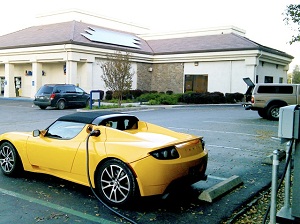SolarCity offers homeowners EV car chargers alongside its photovoltaic systems
 Want to get the most out of a solar system? Add on an electric vehicle (EV) charger. That’s what SolarCity, a solar services company, is new offering.
Want to get the most out of a solar system? Add on an electric vehicle (EV) charger. That’s what SolarCity, a solar services company, is new offering.
SolarCity said July 27 that it is offering the EV chargers in all its 24 service areas throughout 11 states and Washington, D.C.
In addition to its solar services, which include installation, design and financing options—like its SolarLease and power-purchase agreements, among others—SolarCity is now offering ClipperCreek EV chargers.
The 240-volt, Level II chargers start at $1,500. The Level II chargers are roughly five times faster at charging than Level I, 120-volt chargers, the company said. And they’re compatible with most if not all the new production plug-in EV’s now available.
The EV charger is an additional service, said SolarCity spokesperson Jonathan Bass.
“It can’t be rolled into the lease,” said Bass. “You can get the services together. That’s what makes it powerful. If you’re solar powering your electric vehicle charger then you’re reducing the cost of electricity further. We think the services go very well in tandem.”
With a combined solar EV charging system, homeowners can further reduce their energy costs, by selling the power through net-metering in the day—often at higher rates than at night when they’re most likely to charge their electric vehicles. In addition, by eliminating the use of gas, they can further cut their power usage.
Using a solar system and home charger can reduce energy costs by 77 percent, according to SolarCity.
“An average San Francisco Bay Area resident paying the national average of $3.65 per gallon gas spends about $230 per month to fuel her gas-powered car. She’d pay $107 to power an equivalent-size EV with grid electricity, and, by leasing a solar system from SolarCity, only $54 to power the car with solar electricity for the same miles driven,” the company said in press release.
Electricity usage is a key factor in designing a solar system on a home, according to Bass. Since powering an EV with a home charger can lead to a substantial increase in the use of electricity, it can warrant a larger solar system.
“If we were installing an [EV] charger,” he said, “we’d anticipate this.” The system would be designed to accommodate the additional usage.
The only thing lacking is the inability to use the EV’s battery to help power the home at night, which some have suggested would be a great use of EV’s at night.
SolarCity’s working on that too, according to Bass.
“Separately, we’re working on a storage management system using Tesla’s battery’s system,” he said.
The company is working on that with the help of a grant and the University of California, Berkeley.
Image courtesy of SolarCity.



